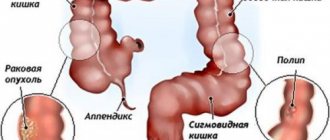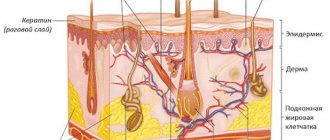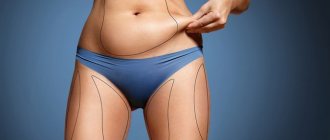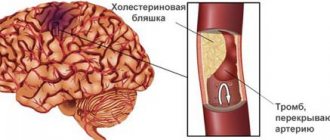What is MRI of the coccyx
During the examination, the tomograph creates a magnetic field and radiofrequency pulses around the patient. Under this influence, hydrogen protons line up in tissue cells for some time parallel to the field, and then return to their original position. During this change, a small amount of energy is released. It is captured by the device’s computer, digitized and recorded as a three-dimensional image on the monitor screen.
The advantages of MRI are:
- Obtaining data not only about the coccyx, but also about neighboring tissues;
- Determination of damage, neoplasms, inflammatory processes;
- The high quality of the images makes it possible to make an accurate diagnosis in one examination;
- During surgery, tomography data can reduce injury to neighboring areas;
- The absence of harmful radiation and safety allow the frequent use of MRI.
Survey
Coccydynia can be diagnosed by physical examination. Patients may assume a forced position in which one buttock is elevated to shift weight away from the tailbone and prevent and/or minimize discomfort and pain. With radiating or radiating pain, it can also occur during movements of the lower back. Coughing can also cause pain. Physical examination may provoke pain during the straight leg raise test. Radiating pain may occur around the buttocks and extend down the back of the thighs. Women may experience pain during menstruation. Palpation of the sacrococcygeal joint will be painful.
Indications
A patient may receive a referral for examination of the coccyx using a tomograph in the following cases:
- Anomalies in the coccygeal region;
- Possible displacement, fracture;
- Suspected tumor, metastases;
- Suspicion of cauda equina syndrome;
- Pain syndrome;
- To confirm previous studies;
- To identify the dynamics of treatment.
Previous Next
What will a tomography of the coccyx show?
During an MRI examination, you can obtain accurate information on the condition of the coccygeal region and:
- Identify congenital or acquired anomalies;
- Detect tissue destruction in the coccygeal region;
- Identify possible post-traumatic changes;
- Find out the condition of the coccyx. When healthy, it represents an inverted pyramid;
- Find out the number of vertebrae that form the coccygeal bone;
- Determine the position of the coccyx, the presence of injuries, fractures, displacements;
- Consider the condition of the vessels that are located in the pericoccygeal region;
- Determine the presence of fistulas, abscesses, as well as tumors and cysts;
- Examine the articulation of the patient’s coccygeal bone and the sacrum;
- Note changes in connective tissue or bones;
- See the presence of degenerative changes.
Coccyx on MRI image
| MRI of the coccyx | MRI of the coccyx with coccydynia |
Initial appointment with a NEUROLOGIST
ONLY 1800 rubles!
(more about prices below)
How to prepare for a tomography of the coccyx and sacrum
No special preparation is required to study the coccygeal region. A person may not change his eating habits and lifestyle. Special instructions can be set by the doctor only if contrast is administered to the patient. As a rule, restrictions include refusing food 2 hours before the procedure.
- MRI
- Ultrasound
MRI tomograph:
Siemens Magnetom C
Type:
Open (expert class)
What's included in the price:
Diagnostics, interpretation of images, written report from a radiologist, recording of tomograms on CD + free consultation with a neurologist or orthopedist after an MRI of the spine or joint
Ultrasound machine
HITACHI HI VISION Avius
Class:
Expert (installation year 2019)
What's included in the price:
Diagnostics, interpretation of images, written diagnostic report
Interesting facts about the bird
- The bird feels good in captivity. The falcon can be kept in a spacious cage. In such conditions, the bird is able to reproduce and get used to purchased feed.
- The birds are trained to hunt pigeons and sparrows.
- The voice of the winged creature sounds like a high and squeaky “ki-ki”. Individuals near the nest are especially noisy.
- The bird got its name from the ancient Russian word “kobets”, which means “small hunting falcon”.
- Often, sharpwings can be found in pastures with farm animals. Birds accompany livestock, snatching insects flying around.
- In captivity, birds can eat not only raw beef or chicken, but also store-bought ham.
- Despite their miniature size, falcons are ready to mate with a heron.
- Birds benefit humanity by eliminating pests in agricultural fields. They also drive away other birds that might eat crops.
- Previously, people clipped the wings of falcons in order to tame them and curb their passion for flying.
- The majority of birds are females, which leads to gender imbalance.
How is an MRI examination of the coccygeal area performed?
When a doctor recommends undergoing an MRI examination, a person immediately has thoughts about how the procedure will go and whether it will be painful. You can immediately calm down - this method is absolutely painless and safe.
Magnetic resonance imaging of the coccygeal area takes place in several stages:
The first step is to remove all metal objects from the body. All chains, rings, belts will need to be removed during the procedure, and all electronic devices - phones, tablets, watches - should be left in the preparation room.
Next, the patient takes a comfortable position on a special table, which slides into the MRI machine. You will have to lie on your back or stomach.
The tomographic scanner will begin its work. It is worth noting that the device sometimes makes specific noises. While the scanner is taking pictures, the patient will hear noises and tapping sounds. To rid yourself of these sounds, you can use earplugs or noise-canceling headphones.
The entire diagnosis usually lasts approximately 15-20 minutes. When the table with the subject leaves the MRI machine, the diagnostic procedure is considered complete.
You can find out the results of the study in about 1 hour. Occasionally this time can be increased to 2 days.
Questions about diagnostics
Dress code
You can enter the MRI room in any clothing that does not contain metal. When going to the clinic, it is best to wear loose, non-restrictive clothing without metal elements (zippers, rivets, hooks), in which you can lie comfortably. For women, we recommend bringing a T-shirt or not wearing a bra with metal wires or hooks.
Preparation
This tomography does not require any preparatory steps from the patient.
Is MRI harmful to health?
MRI is a completely harmless diagnostic method for the human body. This method of examination can be carried out at any age and for any disease an unlimited number of times, unless you have contraindications.
Contraindications
Some pacemakers and foreign objects in the body may pose serious limitations to tomography. In particular, cochlear implants, vascular clips, stents, heart valves and insulin pumps, pacemakers, neurostimulators, steel screws, staples, pins, plates, joint endoprostheses may be a contraindication to diagnosis. The patient must notify the radiologist about all implanted objects in the body. The diagnostician will be able, based on information about the composition and model of the implant, to assess the possibility of conducting diagnostics.
If you are having an MRI with contrast, be sure to report any allergies to medications or kidney problems. It is also necessary to inform the radiologist about a possible pregnancy.
Is it possible to do an MRI with braces and dental implants?
Dental implants and crowns are not a contraindication to magnetic resonance imaging. The magnetic field does not have any negative effect on them. Fixed brace systems can produce artifacts on tomograms during MRI of the head. If the light effect is too strong, the doctor will stop the study and offer the patient alternative diagnostic methods.
Is the device noisy?
Any MRI machine in working condition makes noises reminiscent of tapping. The open tomograph is one of the quietest installations. The noise from its operation is significantly lower compared to closed tomographs. If the sounds of the operating unit cause you anxiety, you will definitely be offered special noise-canceling headphones.
What should I do if I have claustrophobia?
An open tomograph is the optimal solution for patients suffering from panic attacks in a closed space. It is open on the sides on three sides and does not create a claustrophobic feeling.
Can I take sedatives before an MRI?
If you are a little nervous, before the tomography you can take mild sedatives, for example, valerian, motherwort infusion or afobazole. Taking sedatives does not have a negative impact on the quality of MRI.
Why is it important not to move during the test?
Any movement during the examination reduces the quality of the resulting images. Multiple motion artifacts may appear on the images, and the MRI results will be uninformative.
Can I do the research with an accompanying person?
Absolutely yes. You can invite any accompanying person from among your family and friends to the MRI room. It is important that your companion does not have metal implants or artificial pacemakers in his body.
Treatment
Therapy is prescribed only after undergoing an examination and establishing a final diagnosis. If pain in the tailbone is caused by pathology of the abdominal or pelvic organs, then the emphasis is on treating these diseases. If the cause of pain is the tailbone itself, then the doctor can make the following prescriptions.
Nonsteroidal anti-inflammatory drugs
Subluxation of the coccyx
These drugs are used to relieve inflammation and pain due to osteochondrosis, the consequences of injury or sciatica. NSAIDs eliminate the symptoms, but not the cause of the disease.
Drugs in this group include:
- Nimesulide.
- Ortofen.
- Indomethacin.
- Ibuprofen.
Due to the fact that the drugs have many side effects, it is not recommended to take them for a long time.
Local treatment
Ointments and gels with anti-inflammatory and distracting effects are most often used for chronic pathological conditions. They help get rid of low-intensity pain without carrying a general medicinal load on the body. The use of warming ointments in the presence of an inflammatory process is strictly prohibited.
Physiotherapy
The following methods are used:
- Phonophoresis with drugs.
- Magnetotherapy.
- Laser therapy.
- Ozokerite.
- Acupuncture.
- Massage.
Physiotherapy
The selection of exercises is carried out individually depending on the severity of the disease and the general condition of the patient. The goal of gymnastics is to strengthen the muscles of the back, abdominals and pelvic floor. The exercise therapy (physical therapy) complex for the tailbone often includes exercises performed with a ball.
The ball absorbs the load, making movements smooth and rhythmic
Surgery
Surgery is performed only according to strict indications. The basis for the operation are:
- Fistulas and abscesses
- Severe pelvic injuries with damage to bones and internal organs.
- Tumors.
Thus, although the coccyx in humans is considered a rudiment (remnant) of the caudal part of the spinal column, it ensures uniform load on the spine and fixation of a number of internal organs. Its pathology can lead to significant pain and significantly affect the quality of life, so timely diagnosis and treatment are necessary.
Interpretation of MRI results of the coccyx
An example of MRI decoding of the coccyx
Area of study: MRI of the coccygeal spine In a series of MR images weighted by T1 and T2 in the sagittal and axial planes, the structure of the coccygeal vertebral bodies is quite homogeneous, the intensity of the MR signal from the bone marrow of the coccygeal vertebral bodies is moderately increased on T2 and T1-weighted account of fatty degeneration.
Location of the coccygeal vertebrae according to type 1. There were no signs of bone marrow edema of the vertebral bodies. Direct MRI signs of post-traumatic changes are not determined. Presacral fatty tissue is not changed. Conclusion: Initial degenerative-dystrophic changes in the coccygeal spine. It is difficult for an ordinary person to independently understand and interpret the results that, after an MRI, will be given to him on a digital medium. Therefore, with the conclusion of the radiologist and the photographs, he should go for a consultation with the attending physician, who will make a final diagnosis based on the summary data of the examination, medical history and tomography data. In our clinic , after an MRI, you can have a free consultation with a neurologist or orthopedist . Doctor
- will answer all questions based on the results of the research and the conclusion received
- Helps explain tomography results without using complex radiological terminology
- will conduct an examination and, if necessary, offer treatment.
“Second independent opinion” service Medicine is an area where we want to be 100% sure . Therefore, at your request, we will be happy to offer you the service of a second independent opinion from the leading consultant of our clinic, Candidate of Medical Sciences , a doctor of the highest category with 18 years of experience in the field of tomography and radiology N.V. Marchenko.
Description of the bird
The species appeared many thousands of years ago, but the falcon was first mentioned in literature only in the second half of the 18th century. It was only possible to finally find out what the bird looks like at the beginning of the 20th century.
What does it look like
The bird is slightly smaller in size than a dove. Unlike a city dweller, the falcon is much more graceful during flight. Body length – 25-35 centimeters. The wingspan is about 50-70 centimeters. The weight of the bird does not exceed 0.2 kg.
Each sex has distinct anatomical features. Females are larger than males. The feathers are usually gray or black, the belly is red. Gray lines are visible on the back. Females are more colorful. In males, a red coating appears when they reach the ability to reproduce.
According to the existing classification, the individual belongs to the order Falconiformes and the family Falconidae from the genus Falcons. The falcon is a predatory creature, but it cannot kill large game due to its weak and small beak.
Subspecies
There is a subspecies of the common falcon. It is called Amur or Eastern. It differs in the color of its plumage. The Eastern Falcon is light-colored and has bright white cheeks. He has a white belly with spots.
The species is widespread in the Far East, namely in the Mongolian aimags of Dornod, Khentii, and Sukhbaatar. Mongolosphere and the DPRK. In the Russian Federation you can find the Amur species in the Trans-Baikal Territory, Primorye and Amur region. The winged species winters in southern Africa, flying up to 10 thousand kilometers.
Other species are mistaken for falcons. In flight, the falcon is completely mistaken for a wild pigeon. It looks very much like a Hobby. Their main difference is the color of their claws. In the falcon they are light.
Character and lifestyle
Despite its small size, the miniature falcon is quite aggressive. This is an impudent bird that begins an active lifestyle at dawn. At night the falcon rests. The birds do not have their own territory and live in small colonies of 10-20 birds. Rarely does the family number reach hundreds of specimens.
Birds feel great in a team; no problems arise due to divisions of zones. At normal times, it will not be possible to hear the voice of birds. They make sounds while hatching eggs.
Sharp-winged falcons love to fly. They are very mobile. In flight, winged birds gain greater speed, but are inferior to peregrine falcons and merlins.
What does it eat?
The main diet of birds is large insects. Birds happily feed on beetles, bees, wasps, butterflies, dragonflies and locusts. They can catch mice and lizards.
The falcon hunts both on the ground and in the air. It picks up its prey with its tenacious paws. When insects are scarce, the miniature falcon begins to hunt small birds and mammals. Individuals can feed on carrion and eat food from the human table.
The creature’s body is designed in such a way that it constantly needs a lot of protein. If the bird eats food with minimal amounts of it, it will lead to a lack of calcium, which is necessary for good health.
That is why red falcons living in zoos are fed with special vitamin complexes with a high protein content. They are fed massive insects, including Madagascar cockroaches.
Where does it live?
The habitat of birds can be called huge. Birds are found throughout Eurasia - from Ukraine and Poland to the Lena River. The red falcon tolerates temperate continental climates well, but winters in warm countries, as it cannot withstand frost.
A large number of individuals have been recorded in Kazakhstan and the Daurian steppes, in the Far East. Birds live in open areas: in fields, forest-steppes, on the outskirts of high mountains. You can often find them near swamps where there are a lot of insects.
The winged creature never settles in forest areas. It is difficult for him to fly between the trees.
Reproduction
The birds' mating season begins in mid-May. Males court females for a long time, fly over them, perform dances and make interesting sounds.
Birds don't build nests. They prefer other people's houses. Falcons drive out their previous residents, choosing the nests of magpies, rooks, and crows. They may encroach on the place of the kite while it is not there. Sometimes individuals settle in hollows or rocky crevices.
There are usually about 5 eggs in a clutch. Parents hatch them one by one. The chicks hatch after 3-4 weeks. The offspring are gluttonous. Over the course of a month, the male obtains food with short breaks and takes it to the nest throughout the day.
4 weeks after birth, the cubs leave the house. After another month they become completely independent. Average life expectancy is 12-15 years. In captivity, individuals can survive up to 25 years with proper nutrition and care. The creatures are not afraid of people. The individual is able to recognize its owner even after several years.
Birds are very responsible parents. The male always takes care of the female while she sits on the eggs and raises the offspring. The falcon will produce as much food as the family needs.
Natural enemies
Red falcons have no serious enemies. Badgers, wolves, raccoons, and foxes can attack birds. If a predator wants to feast on the chicks, it may end badly for him. The winged ones unite in groups and protect their own. Even a large animal cannot resist such an attack.
Eagles and hawks pose a threat to birds. However, small individuals are very resourceful in the air. It's not that easy to catch up with them.
People pose a separate danger to falcons. Sometimes beekeepers shoot them so that they do not destroy the apiary insects. There are cases that birds suffer from pesticides and other toxic substances that are used to poison various insects. Birds can get sick and die from the chemicals.
Gloves must be used when handling birds manually. Any infection in poultry can be pathogenic, and there is a risk of contracting tetanus.
Birds suffer from various diseases:
- Aspergillosis. This is a fatal fungal infection of the respiratory tract.
- Pododermatitis. Soles of the feet can cause a bacterial infection.
- Infection with trematodes. Parasites are found in many birds of prey.
- Enteritis. Occurs due to a change in food.
- Trichomonosis. A pathogenic infection affects the digestive organs.
The species suffers from electric shock on transmission lines.
Wintering
Red falcons go to warm countries for the winter. They arrive at nesting points in mid-April. The birds move to winter in early October. A school for migration is formed within the flock.
Excellent flying technique is a quality necessary for life. It provides a long flight for wintering in warmer climes.
What determines the price of tomography of the coccyx?
| Service | Price according to Price | Discount Price at Night | Discount Price During the Day |
| from 23.00 to 8.00 | from 8.00 to 23.00 | ||
| MRI of the brain | 3300 rub. | 2690 rub. | 2990 rub. |
| MRI of cerebral vessels (arteries) / MR angiography of cerebral vessels | 3300 rub. | 2690 rub. | 2990 rub. |
| MRI of the brain and cerebral vessels | 6600 rub. | 5380 rub. | 5980 rub. |
| MRI of the pituitary gland (without contrast) | 3500 rub. | 2690 rub. | 2990 rub. |
| MRI of the pituitary gland with contrast | from 6500 rub. | not implemented | from 6900 rub. |
| MRI of the pituitary gland and brain | 7800 rub. | 5380 rub. | 5980 rub. |
| MRI of the central nervous system (MRI of the brain, MRI of the cervical, thoracic and lumbosacral region) | 13200 rub. | 9590 rub. | 10890 rub. |
| Comprehensive head diagnostics (MRI of the brain, MRI of cerebral vessels, ultrasound of neck vessels, consultation with a neurologist) | 10900 rub. | 7500 rub. | |
| Contrast administration (based on patient weight) | from 4000 to 6000 rub. | from 4000 to 6000 rub. |
What determines the cost of tomography?
Tomograph power
Applying Contrast
Personnel qualifications
Promotions and discounts
Medical centers engaged in diagnostics set their own prices for procedures. The cost depends on various factors. The most important of them is the tomograph model. The higher its inductive power, the more expensive the service. In diagnostic centers of St. Petersburg, MRI of the coccyx can be done most cheaply using open-type devices, and the best quality is possible using ultra-high-field tomographs of the latest generation 3 Tesla.
In addition, the price increases when a contrast agent is used. If, according to the doctor’s recommendation, the diagnosis should be carried out with contrast, and the patient underwent tomography without it, then the diagnosis may be made incorrectly.
| OPEN TYPE MRI | SEMI-OPEN MRI | CLOSED MRI |










